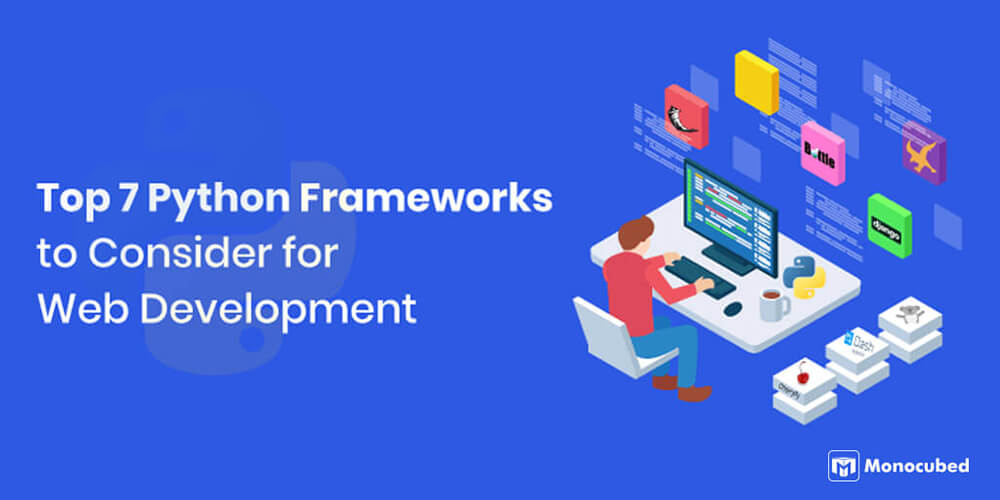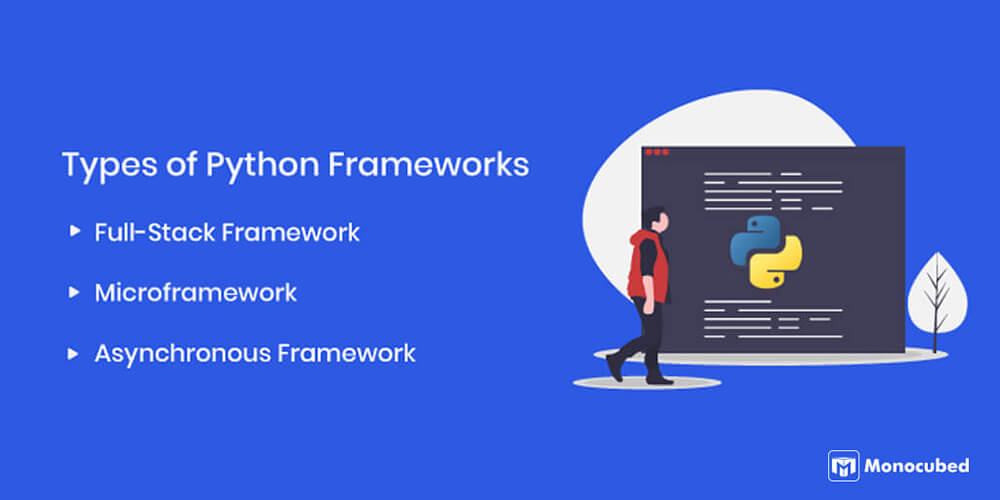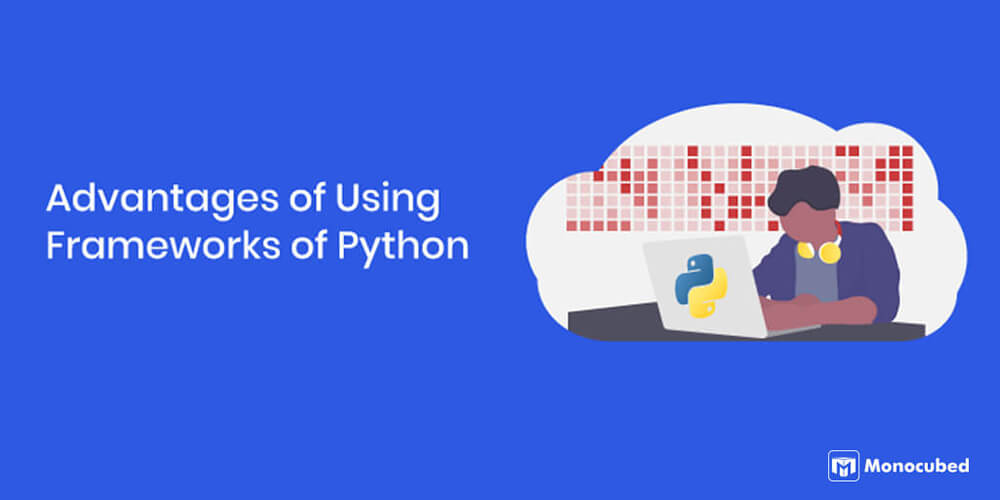In today’s tech era, Python development is climbing new heights of popularity and has become one of the world’s most popular programming languages.
According to Tiobe’s Programming Community Index for 2022, Python is steadily increasing in popularity and remains on the first position as the most popular programming language.
Python is an advanced, interpreted programming language with an easy-to-use syntax and robust libraries that makes it stand out among other web development languages.
If you are developing any Python-based web apps, you should choose any of the most popular Python frameworks to code as it puts a major emphasis on Python for web application development.
Being a leading Python development company, we use Python frameworks in our development project. Here we list the best Python web frameworks to use in 2022.
What is Python used for? Python is a simple, versatile language that fits all areas such as building a web app, DevOps, and data structures.
It is also a top choice for data scientists, researchers looking into new technologies such as Machine Learning, Big Data, Artificial Intelligence and data mining.
Companies that use python such as Netflix, Instagram, Dropbox, are relying on Python as they have a high loading website that processes millions of user requests per day and Python helps them sustain their top-notch performance. Python is also employed by the infrastructure team at Facebook.
To make the most of these Python web frameworks, you must consider a Python web app framework that provides a clear code structure to developers throughout the planning, cross site scripting, SQL injection flaws, file execution, and MVC designing process.
Table of Content
What Are Python Frameworks?
Python web frameworks are a collection of modules or packages which help developers in writing a web application in the Python programming language.
When they choose Python for rapid development, they don’t have to worry about the use of low-level facts, like multiple protocols, thread management, or sockets.
Frameworks automate the performance of basic solutions that provide developers the adaptability to concentrate on websites instead of the general routine processes.
The web development frameworks give website developers, web designers, system administrators, and Linux operators the freedom to develop a structure by providing a default model for app structuring that is quick, consistent, and effortlessly maintainable.
These web application frameworks also diminish the coding time and enable developers to be more focused due to the simultaneous command line (CL) processing and strong typing.
Python backend frameworks have a higher source order abstractions and metaprogramming potential to develop large and complicated code systems and have a variety of libraries for unique features.
Let’s observe a few of the operations involved in web app development that require usage of frameworks for Python:
- URL routing and data-driven manipulation
- Input form validation
- Output formats along with template engines
- Database connection configuration
- Data security against cross-site request forgery (CSRF)
- Session storage and retrieval
To help you out we have listed the top 7 frameworks for Python that you can compare and check out the reasons and features for building your next web project.
7 Top Python Frameworks You Should Consider
If you want to compare the functionalities and features for the project you are going to develop, this section contains a list of the best Python frameworks for software development will help you identify the right one for you.
| Logo | Python Framework | Release Year | Repository | Examples | Core Features |
|---|---|---|---|---|---|
 |
Django | 2005 | Django Github Link |
|
|
 |
Flask | 2010 | Flask Github Link |
|
|
 |
Hug | 2020 | Hug Github Link |
|
|
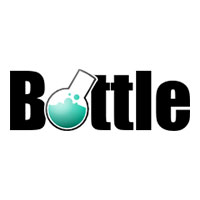 |
Bottle | 2010 | Bottle Github Link |
|
|
 |
CherryPy | 2002 | CherryPy Github Link |
|
|
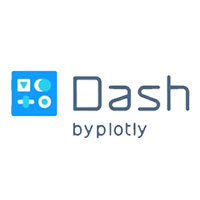 |
Dash | 2019 | Dash Github Link |
|
|
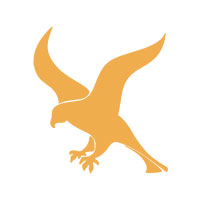 |
Falcon | 2016 | Falcon Github Link |
|
|
-
Django
The Django framework is one of the most used Python web frameworks for developing large-scale web applications and websites. It tends to follow the MVC architecture minutely enough to be known as an MVC framework.
One major reason for its popularity is, it is open source and free to use a full-stack Python framework, also available in maintenance mode, and asyncio library, including a variety of built-in features rather than just offering individual libraries for your projects.
Python and Django are based on the ‘Don’t Repeat Yourself (DRY)’ and ‘Explicit over Implicit’ functionality.
This Python web development framework uses its ORM (Object Relational Mapper) for mapping objects to multi-database tables which allows the code to work across multiple databases and template engines to make it easier to migrate from one database to the other.
Django provides a range of inbuilt libraries and database support – MySQL, SQLite, PostgreSQL, and Oracle. The Python MVC framework also supports other databases and templating systems via third-party adapters, drivers, and content management systems.
Support for localization, user authentication, sessions, cookies, web server, web browser compatibility, is one of the main reasons, Django is considered to be better than other Python frameworks.
Exceptional Features offered by Django Framework:
- A versatile and pleasant ORM
- URL routing and templates
- Ability to run and apply migrations automatically
- Skeleton for automatic generation of admin panel
- Automatic security features such as XSS and CRSF prevention
- Outstanding support for Geographical data and spatial queries through GeoDjango concepts
- An overloaded ready to use libraries
Overall, Django is the best Python backend framework that is apt for developing complex modern web apps.
-
Flask
Flask is another well-known and best Python framework that comes under the Microframework category and comes with the BSD license. It is inspired by the Sinatra Ruby framework.
It needs the Werkzeug WSGI toolkit and the Jinja2 template, and ToscaWidgets is an example of a WSGI framework. Dash developers can utilize Flask as a web framework.
Thanks to the functionality, restful request dispatching, request handling, modular, and lightweight frontend design of Flask, it is more adaptable than Django.
ORMs deliver an advanced abstraction on an interactive database that lets a developer transcribe code in place of SQL to read, create, delete, and update tools and data in the database.
Flask is a framework of Python language that allows the users to build a genuine web app foundation and database tables from where they can use any source of extensions needed.
The other benefit of using this framework is that it is compatible with Google App Engine and offers a request dispatching way. For instance, 21% of Facebook Infrastructure has Python codebase.
Flask Framework offers the following features:
- Routing, templating language, session management, etc.
- Complete support for unit-testing
- Inbuilt development web server
- Error logging and ticketing role based access control to administer errors
- A minimum, pluggable model
- First-class REST support and coordination
- Flask gives support for Blueprints
- Plugging in any ORM and secure cookies
- Static file uploads and serving
- Flexible web application section
- WGSI compliant with HTTP request handling
- Built-in fast debugger
- Jinja2 templating views
- Unit testing support
- Error tracking mechanism
- RESTful request dispatching
- Unicode-based source
-
Hug
The Hug is a Python 3 API framework that allows the Python developers community for building APIs and then they can use it whenever they want to.
This framework has the ability to simplify restful API construction and prototyping as it offers multi-threaded interfaces. It is also considered as the fastest web frameworks in Python if you are using Python 3 in your organization.
It lets web developers complete app formation easily in one click deployment, over HTTP requests or responses, or via the CLI.
Hug framework has little integration and developers need code coverage as little as possible to remain functional, and provide high performance. In order to take the app performance to the next degree, it uses resources only whenever it is needed and employs Cython as a source for compilation.
On top of that, its community is still growing and the demand in the market is increasing and whenever an issue occurs, a developer can find help in any parts of the web application development.
Key features included in Hug Framework:
- Annotation-powered validation
- Follows write once, use anywhere philosophy
- Built-in version management
- Supports automatic documentation
- Built-in version management
- Compliance with Cython
- Ability to run and use as Python standard library
-
Bottle
The Bottle framework is one of the most used micro-framework that the web development community uses to build various web applications using Python.
It does not have many dependencies, as an alternative, it contains only one Python standard code library and employs in a single file. Also, it is distributed as a source file module.
This library also includes an inbuilt template engine, exceptions, and functions – the objects that can be utilized by Python code without any requirement of the import statement.
One of the key features of this framework is that it makes developers’ lives easier by allowing them to perform closer to the hardware.
This small, powerful framework is ideal for programmers looking for flexibility and basic functionalities to build simple web applications and websites with third-party HTTP/WSGI servers.
Another benefit of using Bottle is that its small profile makes it trouble-free to embed it within a larger app without worrying about system-wide requirements.
For instance, if you want to create small apps for your business with a clean, simple, and fast framework that is not full of words, Bottle is everything you need.
Key Features of Bottle framework:
- Built-in fast template engine
- Supports Jinja2, Mako, and Cheetah
- Built-in HTTP development server
- Support for dynamic URL generation
- Plugin support for different databases
- Support for file uploading, headers, and cookies sessions
- No external dependencies
-
CherryPy
Just like Django, CherryPy also comes under open-source web development frameworks that mainly use the object-oriented paradigm.
It comes with its own HTTP/1.1 compliant WSGI multi-strung Python web servers for developing web applications in a short period of time.
Developers, as per their coding styles, can build the application and database connectivity with this framework. They can also view on their multi-threaded web server.
The core advantage of using this framework’s menu is that you can run applications on all Python-supported operating systems including Windows, Mac, and Linux or Unix.
It is the best framework for Python that allows developers to quickly develop a smaller source of codes and form a reliable database It offers controller modules and a setup framework that makes things easier for data access, file uploads, templating engines, and handling of sessions.
Also, it provides built-in support for documentation tasks such as coverage, testing, and profiling for your projects. The core distinction of CherryPy is that the user can run multiple HTTP web servers simultaneously.
If people want to use a framework in Python language that is super fast, super stable, and super reliable, then they can trust CherryPy.
Feature Checklist For CherryPy Framework:
- HTTP/1.1-compliant WSGI thread-pooled web server
- Multiple HTTP Server Support
- Powerful installation and configuration system
- Flexible plugin system
- Minimalism concepts
- Faster development time
- Android Compliant
Require a Python Solution?
Get custom-made Python web applications with all the features you require. Talk to us and start developing.
-
Dash
Dash is also an open-source micro-framework that is exclusively designed for developing analytical apps.
Data scientists prefer this framework because it is built on Flask, ReactJs, and Plotly.js and does not demand much knowledge of the tech stack of Python with web development frameworks.
Dash allows developers to create everything with a click that is needed for strong database management and a cross-platform, mobile-ready web app.
This popular Python framework has two parts, one is a layout that describes how the appearance of the app will be and another is functionality that describes its interactivity with the users.
Dash provides a great number of database customization options to make it simple to build Python dashboards. Its straightforward interface is useful in representing UI controls on value property events like dropdowns, graphs, and sliders.
This is the best Python web framework, facilitating the advancement of HTML classes to create HTML web content.
Key Features of Dash Framework:
- Simple UI
- Low Demand for Boilerplate Code
- Error Loading Layout
- LDAP Integration
- Customizability
- Plugin Support
- URL routing and data manipulation
-
Falcon
Falcon is aimed at building web APIs such as configuration files.
Falcon enables developers to develop pure design applications to improve and use the existing ones that allow HTTP servers.
Unlike other Python backend frameworks that need lots of reliance for building HTTP APIs, Falcon has an accurate and efficient response for HTTP errors and threats or vulnerabilities.
Falcon is capable of handling most requests with the same hardware compared to other contemporaries. Big players like LinkedIn, OpenStack, and RackSpace are using Falcon for their platforms.
Features offered by the Falcon Framework:
- An extensible, highly-optimized code base
- Unit testing via WSGI helpers and mocks
- Upfront exception handling
- REST-inspired resource classes
- Additional speed boost with Cython support
- Middleware components and hooks
- DRY request processing
- URL templates offer intuitive routing
Different Types of Python Web Frameworks
While talking about the availability of open-source Python frameworks, there are basically three types of frameworks – full-stack frameworks like Web2py and Pyramid, micro web framework like Dash and CherryPy, and asynchronous frameworks like Sanic and Growler.
Let us have some views on these frameworks.
-
Full Stack Framework
Full stack are one of the best Python web application frameworks, known as one-stop-solution for fulfilling all kinds of app building requirements. This approach has a lot of databases and components that are commonly included in the full-stack framework such as – form validation, form generators, and template layouts.
Here are some examples of full stack frameworks:
- CubicWeb
- Django
- Web2Py
- Giotto
- Pylons Framework
- Pyramid
- TurboGears
From the above list of full-stack Python frameworks, Web2py, an open-source framework, permits developers to create robust code by using the object-oriented pattern with the utmost ease. It is written in Python and is fabricated to diminish tiresome program agendas, such as building web-based visualization forms from the beginning.
One of them is CubicWeb that embeds Relational Query Language (RQL) with an aim to simplify any query related to the data.
Whereas, Pyramid is a lightweight framework intended to turn trivial web technologies into huge one. Pyramid operations are carried on all versions of Python.
Pylons combine the best ideas from the ecospheres of Python, Perl, and Ruby, enabling an organized and flexible framework.
-
Micro-framework
These kinds of web application frameworks are known as the lightweight framework (non full stack framework) because they do not offer additional patterns and functionalities compared to a full stack framework, such as multi-threaded database abstraction layer, form validation, specific tools, and libraries.
The users who want to use this open-source Python web framework must put a lot of effort to form code, and need to add additional requirements and operations manually.
Some of the best Python web frameworks of this type are:
- Bottle
- CherryPy
- Dash
- Falcon
- Flask
- Hug
- MorePath
- Pycnic
-
Asynchronous Framework
Asynchronous web frameworks are now taking over its place as a microframeworks that allows a user to handle large sets of concurrent connections.
Characteristically, an asynchronous web framework is mainly built for Python which uses the asyncio networking library of programming languages.
Sanic is a server web framework that allows developers to use async/await syntax which is included in Python 3.5. The aim of the Sanic assignment is to supply an easier way to function in a high-performing HTTP server that is simple to construct and scale and supports request handlers.
According to the benchmark test held by Sanic, Falcon’s capabilities of managing most of the requests with similar hardware is best as compared to all its contemporaries.
- AIOHTTP
- Growler
- Sanic
- Tornado
Advantages of Using A Python Framework
Why is a framework necessary for Python developers? Can’t you simply write the whole application code in a code editor or IDE?
Using a framework is extremely useful when building web applications and websites. Along with a more organized code, frameworks also increase productivity and simplify the whole web development process.
Some advantages of using an open source Python framework are listed below.
- Code reusability
- Easier implementation
- Good documentation
- Efficient operations
- Secure framework
- Easy Integration
So, now you know what you want and what type of web framework you need to use for developing an open source web application based on the Python programming language.
To help you out we have listed the top 7 frameworks for Python that you can compare and check out the reasons and features for building your next web project.
Things to Know Before You Choose The Right Web Framework
According to Stack Overflow, 67.8% of web developers prefer Python as their programming language for web development. Python is the top choice, fourth year in a row, as the technology most developers want to use someday.
But there are certain things that companies need to consider before deciding which web development framework they should use. First of all, it needs to look at the size and complexity of the coding strategy.
If you are planning to develop a large structure filled with lots of requirements and features, a full-stack framework will be the right choice. On the other hand, if it is planning a small and simple app product, you should think about microframeworks.
Secondly, you need to check if the framework you are choosing is up to the mark and perfectly fits your web project.
This is an important step to remember while choosing the right framework for the projects that require running on several web servers, handling vast amounts of traffic, and supporting new additional features to excel code functionality.
Confused Which Web Framework to Use?
Don’t worry. You can consult with our experts for free. Find the right frameworks and tools for your project.
Frequently Asked Questions
-
What is framework in Python?
Web application framework for Python is a collection of elements and modules that allows web developers to incorporate function decorators with Python and/or services without having low-level details such as sockets, process/thread management, and multiple protocols. There are primarily three types of most popular Python frameworks for web development, namely full-stack, micro-
framework, and asynchronous which are considered as the best web framework for Python. -
What is best framework for Python?
Among the dynamic Python frameworks available, Flask and Django are the most popular ones. Still, the decision to opt for a framework completely depends on the requirements of the project. Some of the best Python frameworks are CherryPy, Bottle, Pyramid, Hug, Falcon, which will aid you to build an efficacious project.
-
How many Python frameworks are there?
As we have mentioned there are three kinds of popular frameworks for web development, namely full-stack, micro-framework, and asynchronous which businesses consider to build web applications with Python.
Conclusion
Looking at the above-given details in the blog, you need to choose the right web framework depending on the extent of the project and communication needs (whether it is an individual app or not), the status of customization that is required, and everything that you aim for.
It also depends on the developer’s personal choice, working style, and comfort for coding.Compare the features of the above-given frameworks and choose the best suitable for your project.
At Monocubed, we will help you choose the appropriate Python framework for web development based on your requirement. Contact our experts now, if you want to develop a successful project.
 By Jeel Patel
By Jeel Patel
